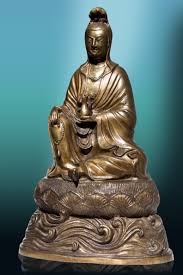Table of Gods
Your guide to the World gods, spirits,
demons and legendary monsters

The Origin of Chinese Gods
-
GongGong - the God of Water
Gong Gong is the God of Water in ancient Chinese mythology and also believed to be the descendant of the Yan Emperor. The archetype of Gong Gong dates back to a powerful tribal leader in the period of the Three Emperors and Five Sovereigns....
-
Tianlu and Bixie
Tianlu (heavenly emolument) and Bixie (evil dispeller) are two Chinese mythological animals that herald in good fortune and keep evil at bay. Both look like a lion except for their wings--the one with only one horn on his head is tianlu and...
-
Pixiu
Also known as Tianlu or Bixie, Pixiu is one of the five auspicious animals in ancient Chinese mythology, the other four being the dragon, phoenix, tortoise, and Chinese unicorn. Pixiu is considered a wealth-bringing divine animal with a dra...
-
Kylin
The kylin is an animal in ancient Chinese mythology. The kylin has a compound appearance with dragon's head, antlers, horse's hoofs, an oxtail, wolf's forehead and a colorful scute. It is lively, intelligent, and gentle, but valorous to war...
-
King Yama - Chinese God
If you have read the Journey to the West, maybe you have idea who is King Yama, and the post of his. According to ancient China mythology, In Chinese folk beliefs, King Yama is the judge of the dead, who presides over the hell and is respon...
-
The Legend of Nian Monster
Chinese people held the first New Year Festival more than 3,000 years ago. Farmers gave thanks for the harvest and prayed. They asked the gods for good crops in the coming year. But there is a story behind all the celebration, below is the...
-
Chinese Door Gods
The images of the Door Gods were mostly based on the Four Heavenly Kings in the temples. They were the four heavenly dharma protectors of Buddhism. They originated from the Indian mythol- ogical Four Heavenly Kings to protect the world in t...
-
The Kitchen God
The Kitchen God, also known as the Kitchen King or Kitchen Lord, was respected and wor- shipped by emperors and commoners alike. It is said the god as an envoy was sent by the Jade Emperor in Heaven to every household in the mundane world t...
THE GOD OF WEALTH
-
The Impact of Zhong Kui is Ghost-Taming on Posterity
The tales about Zhong Kui's taming and devour- ing ghosts became current in the Tang Dynasty, when Emperor Xuanzong ordered the pictures of Zhong Kui hung at the end of a year. By Dezong's reign in the mid-Tang period, the emperor made it a...
-
Zhong Kui Tames the Ghosts
What were the ghosts that Zhong Kui was out to exterminate? The answer to this question is found in a memorial the Kings of Ten Hells presented to the Jade Emperor: As administrators of the nether world, your humble subjects feel duty bound...
-
Tales About Zhong Kui Taming Ghosts
In the old days, the picture of Zhong Kui was ted on the walls of almost all Chinese homes. He was represented as a fierce warrior with the head of a leopard and an imposing figure, wearing whisk- ers, a long robe, a pair of boots, and poin...
-
The Statue of Guanyin in Dule Temple
Inside the West Gate of Jixian County (ancient Yuyang) in the suburbs of Tianjin is Dule Temple, where a twenty-three-metre-high Guanyin Pavilion houses an exquisite sixteen-metre-high statue of Guanyin. The pavilion consists of three level...
-
The Bestower of Children and Wealth
This refers to the boy, Sudhana, standing on the left side of Avalokitesvara in Chinese temples and monasteries. This bodhisattva of the Buddhist faith is an instance of the possibility for one to attain Buddhahood through self-cultivation...
-
Tales About the Thousand-Eye and Thousand-Hand Bodhisattva
Tales about Guanyin also changed with the ap- pearance of the bodhisattva in female form. By the Northern Song Dynasty, many of the tales had been related to Chinese history. One said that she was Miao Shan, the third daughter of Prince Zhu...
People worship the God of Wealth because they Want to live a happy, affluent life. Every year on the Spring Festival (Lunar New Year), every family makes a practice of welcoming the God of Wealth and offering sacrifices to him, before membe...
